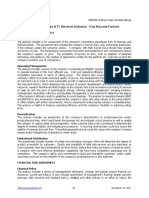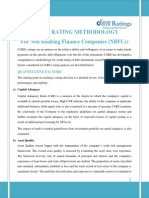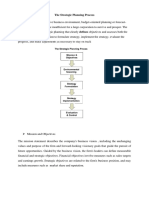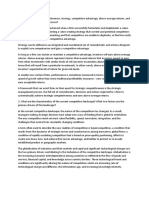Automotive Industry - Key Success Factors: Business Risk Assessment Market Position
Automotive Industry - Key Success Factors: Business Risk Assessment Market Position
Uploaded by
raghulCopyright:
Available Formats
Automotive Industry - Key Success Factors: Business Risk Assessment Market Position
Automotive Industry - Key Success Factors: Business Risk Assessment Market Position
Uploaded by
raghulOriginal Description:
Original Title
Copyright
Available Formats
Share this document
Did you find this document useful?
Is this content inappropriate?
Copyright:
Available Formats
Automotive Industry - Key Success Factors: Business Risk Assessment Market Position
Automotive Industry - Key Success Factors: Business Risk Assessment Market Position
Uploaded by
raghulCopyright:
Available Formats
PEFINDO Rating Criteria & Methodology
Automotive Industry - Key Success Factors
BUSINESS RISK ASSESSMENT
Market Position
The analysis covers deep risk assessments on the company's competitive advantages from its business and
market position. Given lack of information on the industry sales values, sales volumes are used as a proxy
to estimate the company’s market share. The examination is further broken down to the company's market
share in different segments, manufacturers, types of products, brands, and etc. Strong market share is
important to determine the company's capability in negotiating with its principal, suppliers, distributors,
and regulators. A company with the largest market share also often becomes the price leader, offering
more flexibility to adjust selling prices. In addition, strong market position could provide the company a
better resistance towards any unfavorable business development as compared to a company with smaller
and weaker business position. The analysis also reviews several other important factors that affect the
company's market share such as brand awareness, product quality, product mix strategy, pricing strategy,
reliability, after sale services, and principal supports and commitments.
Operating Management
The analysis includes careful reviews on the company's margin management in an effort to operate
businesses in the most efficient way. Examination on utilization of factory capacity is one of the main factors
to see the degree of efficiency, as production activities in automotive industry usually involve sizable fixed
costs. In addition, as revenues of automotive manufacturers are mainly in Rupiah, the analysis also includes
deep reviews on the company's capability to localize materials, reduce currency mismatch between revenue
and material costs, and pursue foreign currency revenue by exploring the export market. The principal's
global strategy, supports, policy as well as capability and flexibility to penetrate the export market are also
examined. Working capital management, including inventory management, receivable collection, and
payable management, is also analyzed to determine the degree of the company's efficiency and capability
to run businesses. The analysis on operating margins (EBIT and EBITDA) is also assessed by comparing
the company’s ratios with other players in the same industry or other industry with similar characteristics,
which is important in analyzing the company’s competitiveness. The analysis is helpful to measure
operating efficiency and the company’s flexibility in adjusting selling price.
Product Range and Development
The analysis covers the examinations on the company's ability to offer variety of products that enables the
company to capture wider market segments with different demand characteristics. Having strong position
in many market segments will offer more stable revenue stream than that of those who only focus on single
market segment. The company's capability to follow customers' rapidly changing preferences and needs is
also evaluated to see the degree of the company's ability in product development that is generally measured
by the company's facility, human resources and amount of the budget for research and development (R&D).
Marketing and Distribution
The analysis covers thorough examinations on the company's marketing and distribution networks that
enable the company reaching wider customer base. The company's ability, policy and commitment to
advertise and strengthen customers' awareness on the products, distribution network to ensure product
availability in targeted market place are also thoroughly analyzed. Extensive distribution networks should
offer better geographic diversity, which in turn is expected to lighten revenue instability from certain
marketing area/location. The company's strengths on marketing and distribution networks should be
reflected by number and distribution of branches, dealers, workshops, and supports from financing
companies as well as spare-part provider networks.
http://www.pefindo.com 1/3 December 19, 2019
PEFINDO Rating Criteria & Methodology
FINANCIAL RISK ASSESSMENT
Financial Policy
The analysis includes a review of management's philosophy, strategy and policies toward financial risk
(historical, current and future). It also includes examination of management's financial targets (growth,
leverage, debt structure and dividend policy), hedging and other policies in an effort to reduce the
company's overall financial risk (historical vs. future). The company's track record on fulfilling its previous
financial obligations is also examined to determine the degree of its commitments and willingness and
consistency to pay obligations on a timely basis.
Capital Structure
The analysis covers careful examination of the company's historical, current and projected leverage (total
and net debt in relation to equity and EBITDA), debt structures and composition (rupiah vs. foreign
currencies, short-term debt vs. long-term debt, fixed rate vs. floating rate). Management of its liabilities is
also thoroughly reviewed.
Cash Flow Protection And Liquidity
The analysis covers thorough reviews of the company's cash flow generation and capability to meet its
short-term and long-term financial obligations. The degree of its debt-servicing capability level is measured
by the company's interest and debt coverage ratio. The degree of its liquidity in fulfilling its short-term
liabilities relative to its sources of cash is also thoroughly assessed. The sources of cash are assessed, which
include cash balance, estimated cash from operations, unused credit facilities, and other sources of cash.
The uses of cash other than short-term liabilities, such as capital expenditure, are also assessed.
Financial Flexibility
The analysis covers combined evaluations of all the financial measures above to arrive at an overall view
of the company's financial health. Analysis of other related factors or figures that are not specifically
examined above, such as insurance coverage, restrictive covenants in loan/bond agreements or parental
linkage and support, are also covered. Other analytical tasks covered are the evaluation of the company's
options under stress, including contingency plans and other capabilities and flexibility to deal with various
adverse scenarios. Shareholder support and commitment are also greatly considered.
http://www.pefindo.com 2/3 December 19, 2019
PEFINDO Rating Criteria & Methodology
DISCLAIMER
The rating contained in this report or publication is the opinion of PT Pemeringkat Efek Indonesia (PEFINDO) given based on the
rating result on the date the rating was made. The rating is a forward-looking opinion regarding the rated party’s capability to meet
its financial obligations fully and on time, based on assumptions made at the time of rating. The rating is not a recommendation for
investors to make investment decisions (whether the decision is to buy, sell, or hold any debt securities based on or related to the
rating or other investment decisions) and/or an opinion on the fairness value of debt securities and/or the value of the entity assigned
a rating by PEFINDO. All the data and information needed in the rating process are obtained from the party requesting the rating,
which are considered reliable in conveying the accuracy and correctness of the data and information, as well as from other sources
deemed reliable. PEFINDO does not conduct audits, due diligence, or independent verifications of every information and data received
and used as basis in the rating process. PEFINDO does not take any responsibility for the truth, completeness, timeliness, and accuracy
of the information and data referred to. The accuracy and correctness of the information and data are fully the responsibility of the
parties providing them. PEFINDO and every of its member of the Board of Directors, Commissioners, Shareholders and Employees
are not responsible to any party for losses, costs and expenses suffered or that arise as a result of the use of the contents and/or
information in this rating report or publication, either directly or indirectly. PEFINDO generally receives fees for its rating services from
parties who request the ratings, and PEFINDO discloses its rating fees prior to the rating assignment. PEFINDO has a commitment in
the form of policies and procedures to maintain objectivity, integrity, and independence in the rating process. PEFINDO also has a
“Code of Conduct” to avoid conflicts of interest in the rating process. Ratings may change in the future due to events that were not
anticipated at the time they were first assigned. PEFINDO has the right to withdraw ratings if the data and information received are
determined to be inadequate and/or the rated company does not fulfill its obligations to PEFINDO. For ratings that received approval
for publication from the rated party, PEFINDO has the right to publish the ratings and analysis in its reports or publication, and publish
the results of the review of the published ratings, both periodically and specifically in case there are material facts or important events
that could affect the previous ratings. Reproduction of the contents of this publication, in full or in part, requires written approval
from PEFINDO. PEFINDO is not responsible for publications by other parties of contents related to the ratings given by PEFINDO.
http://www.pefindo.com 3/3 December 19, 2019
You might also like
- Question and Answers For FRONT OFFICE SERVICES NC IIDocument8 pagesQuestion and Answers For FRONT OFFICE SERVICES NC IIAsh Gabbie100% (2)
- FIN 320 Project One Financial Analyst Job AidDocument3 pagesFIN 320 Project One Financial Analyst Job AidghanaNo ratings yet
- School of Business: Auditing BBAC2054Document22 pagesSchool of Business: Auditing BBAC2054JoeyNo ratings yet
- WE Responses, Part 1Document52 pagesWE Responses, Part 1CANADALAND0% (1)
- Information Technology & IT Services IndustryDocument3 pagesInformation Technology & IT Services IndustryAlukwu JudeNo ratings yet
- Manufacturing Bisnis N Finance RaiskDocument2 pagesManufacturing Bisnis N Finance RaiskFerlyan Huang 正莲No ratings yet
- Tobacco Industry - Key Success Factors: Business Risk Assessment Market PositionDocument3 pagesTobacco Industry - Key Success Factors: Business Risk Assessment Market PositionGunadeep ReddyNo ratings yet
- Retail IndustryDocument3 pagesRetail IndustryakavinashkillerNo ratings yet
- Key Success Factors of The Pharmaceutical IndsustryDocument2 pagesKey Success Factors of The Pharmaceutical Indsustrybenj_morgan100% (1)
- Electricity Power Industry - Key Success Factors: Business Risk Assessment RegulationDocument2 pagesElectricity Power Industry - Key Success Factors: Business Risk Assessment Regulationanubhav saxenaNo ratings yet
- Key Success Facotr GeneralDocument3 pagesKey Success Facotr GeneralprashantNo ratings yet
- Mining Industry - Key Success Factors: Business Risk Assessment Cost PositionDocument2 pagesMining Industry - Key Success Factors: Business Risk Assessment Cost PositionJonas ArifinNo ratings yet
- Special Financial Institution IndustryDocument2 pagesSpecial Financial Institution IndustryAVINASH KUMAR SINGHNo ratings yet
- Critical Succucess FactorDocument3 pagesCritical Succucess FactorHimansh SagarNo ratings yet
- Banking Industry KSFDocument3 pagesBanking Industry KSFAdam AmruNo ratings yet
- Banking Industry - Key Success Factors: Business Risk Assessment Market PositionDocument2 pagesBanking Industry - Key Success Factors: Business Risk Assessment Market PositionrahidarzooNo ratings yet
- Toll Road Industry - Key Success Factors: Business Risk Assessment Economy of Service AreaDocument3 pagesToll Road Industry - Key Success Factors: Business Risk Assessment Economy of Service Arealuqm4n99No ratings yet
- BANKING INDUSTRY - Key Success Factors: Business Risk Assessment Market PositionDocument2 pagesBANKING INDUSTRY - Key Success Factors: Business Risk Assessment Market PositionGary YuthianNo ratings yet
- Meaning of RatioDocument3 pagesMeaning of RatioVishnu VamshiNo ratings yet
- Objectives of Credit Rating: Financial Statements CreditworthinessDocument6 pagesObjectives of Credit Rating: Financial Statements CreditworthinessvishNo ratings yet
- Question/ Answer of Strategic ManagementDocument13 pagesQuestion/ Answer of Strategic ManagementÀmc Chaudhary100% (2)
- Www Investopedia Com Terms f Fundamentalanalysis ASPDocument15 pagesWww Investopedia Com Terms f Fundamentalanalysis ASPRon TraskNo ratings yet
- Chapter 4 C CREDIT RATINGDocument8 pagesChapter 4 C CREDIT RATINGCarl AbruquahNo ratings yet
- Manufacturing CompaniesDocument5 pagesManufacturing CompaniesVineet_Sharma_9432No ratings yet
- XCFBJJKMDocument33 pagesXCFBJJKMApurbh Singh KashyapNo ratings yet
- Financial RatiosDocument4 pagesFinancial RatiosDzul ArifNo ratings yet
- Financial Reporting and Disclosure - CurrentDocument31 pagesFinancial Reporting and Disclosure - Currentcliffton malcolm tshumaNo ratings yet
- Analysis and Uses of Financial StatementsDocument144 pagesAnalysis and Uses of Financial StatementsPepe ArriagaNo ratings yet
- Chapter 3 - Lesson 3 (BF)Document19 pagesChapter 3 - Lesson 3 (BF)Ziedwrick Ayson DicarNo ratings yet
- Act 12Document4 pagesAct 12Jael AlmazanNo ratings yet
- Financial Analytics NotesDocument38 pagesFinancial Analytics Notessridhara.ramkarthik173No ratings yet
- I. Overview of Financial Statement AnalysisDocument70 pagesI. Overview of Financial Statement AnalysisGeofrey RiveraNo ratings yet
- Non Banking Financial CompaniesDocument6 pagesNon Banking Financial CompaniesKedyParabNo ratings yet
- Financial Ratio Analysis of Firms A ToolDocument6 pagesFinancial Ratio Analysis of Firms A ToolمريمالرئيسيNo ratings yet
- QuestionsDocument2 pagesQuestionsJoe DicksonNo ratings yet
- Assignment 2Document8 pagesAssignment 2josphatchm1No ratings yet
- Module 6 FINP1 Financial ManagementDocument28 pagesModule 6 FINP1 Financial ManagementChristine Jane LumocsoNo ratings yet
- The Strategic Planning ProcessDocument10 pagesThe Strategic Planning ProcessSyed Faiz QuadriNo ratings yet
- Financial Reporting and Analysis Solutions The Economic and Institutional Setting For Financial Reporting ProblemsDocument28 pagesFinancial Reporting and Analysis Solutions The Economic and Institutional Setting For Financial Reporting Problemsdgunnarsson_4No ratings yet
- The Economic and Institutional Setting For Financial ReportingDocument48 pagesThe Economic and Institutional Setting For Financial Reportingcatelyne santosNo ratings yet
- Chapter - 1 Introduction: 1.1 Background of The StudyDocument78 pagesChapter - 1 Introduction: 1.1 Background of The StudyPRIYA RANANo ratings yet
- Act 1Document4 pagesAct 1Jael AlmazanNo ratings yet
- SM Quiz1Document4 pagesSM Quiz1Ah BiiNo ratings yet
- CHAPTER 6hshshsWPS OfficeDocument78 pagesCHAPTER 6hshshsWPS OfficeKris Van HalenNo ratings yet
- Solution Manual For Financial Reporting and Analysis 7th Edition by RevsineDocument56 pagesSolution Manual For Financial Reporting and Analysis 7th Edition by Revsinemuepusupli72No ratings yet
- Mandatory and Voluntary Disclosure On Annual ReportDocument3 pagesMandatory and Voluntary Disclosure On Annual ReportKhanh LeNo ratings yet
- Fundamental AnalysisDocument22 pagesFundamental AnalysisDanilo FreitasNo ratings yet
- FM .pdf-1Document40 pagesFM .pdf-1Ace TevesNo ratings yet
- Financial Diagnosis - Approaches and ComplementaritiesDocument4 pagesFinancial Diagnosis - Approaches and ComplementaritiesCristina CristianNo ratings yet
- Investor / Analyst Presentation (Company Update)Document48 pagesInvestor / Analyst Presentation (Company Update)Shyam SunderNo ratings yet
- External Audit ReportDocument3 pagesExternal Audit ReportWarren AcostaNo ratings yet
- Midterm Fin Oo4Document82 pagesMidterm Fin Oo4patricia gunio100% (1)
- Strategic Planning and Project ManagementDocument3 pagesStrategic Planning and Project Managementbtsvt1307 phNo ratings yet
- Assignment On: Financial Statement Analysis and Valuation Course Code: (F-401)Document7 pagesAssignment On: Financial Statement Analysis and Valuation Course Code: (F-401)Md Ohidur RahmanNo ratings yet
- Corrected BrandDocument63 pagesCorrected BrandRajesh KhannaNo ratings yet
- Mainbody Shikhar-InsuranceDocument28 pagesMainbody Shikhar-InsuranceBadri mauryaNo ratings yet
- Financial Ratio Interpretation (ITC)Document12 pagesFinancial Ratio Interpretation (ITC)Gorantla SindhujaNo ratings yet
- Financial Ratio Analysis of Firms A ToolDocument6 pagesFinancial Ratio Analysis of Firms A ToolNIKAY CARTERNo ratings yet
- Relationship Between A Case Analysis and Financial Analysis PDFDocument10 pagesRelationship Between A Case Analysis and Financial Analysis PDFMohamed50% (2)
- FVRR Company Presentation August 2022 (Confidential)Document45 pagesFVRR Company Presentation August 2022 (Confidential)Veronica Alvarez PerezNo ratings yet
- Chapter 4Document14 pagesChapter 4maindingjelynNo ratings yet
- Strategic Anlysis and ChoiceDocument15 pagesStrategic Anlysis and ChoiceAnonymous IEF3VVwyiINo ratings yet
- 01 Steppe Cement Group Case StudyDocument2 pages01 Steppe Cement Group Case StudyPhạm Thanh HuyềnNo ratings yet
- Journal Summary About: BackgroundDocument4 pagesJournal Summary About: BackgroundAnggun MerlyanaNo ratings yet
- REFUNDDocument52 pagesREFUNDarpit85No ratings yet
- Print - Winding Up of Company - An Overview - TaxGuruDocument8 pagesPrint - Winding Up of Company - An Overview - TaxGurusanamja1No ratings yet
- CM121 Cost Accounting ManualDocument252 pagesCM121 Cost Accounting Manualsama tahsinNo ratings yet
- Usl MS 01Document6 pagesUsl MS 01myrnabalisi8No ratings yet
- Financial Reporting and Management Reporting SystemsDocument44 pagesFinancial Reporting and Management Reporting SystemsGlazerie Quijano GalabinNo ratings yet
- Internal Audit, Management and Operational AuditDocument14 pagesInternal Audit, Management and Operational AuditNeetu gargNo ratings yet
- Annex 5 How To Follow The Zero Tolerance ProtocolDocument6 pagesAnnex 5 How To Follow The Zero Tolerance ProtocolFabiola FranciaNo ratings yet
- Auditing Book Gobind Kumar JhaDocument145 pagesAuditing Book Gobind Kumar Jhabinay chaudharyNo ratings yet
- ACCA P1 Mock1 Answers June2018 PDFDocument28 pagesACCA P1 Mock1 Answers June2018 PDFKaran Bungshee Sr.No ratings yet
- Supplementary Material Module 5Document10 pagesSupplementary Material Module 5Darwin Dionisio ClementeNo ratings yet
- Internship Report Fauji Fertilizer Bin Qasim Limited: Supervisor: Dr. Ali Raza Duration: 8 July - 16 AugustDocument40 pagesInternship Report Fauji Fertilizer Bin Qasim Limited: Supervisor: Dr. Ali Raza Duration: 8 July - 16 AugustIqraNo ratings yet
- A.narayana ResumeDocument3 pagesA.narayana ResumevinayakNo ratings yet
- Sa 3 EssayDocument3 pagesSa 3 EssayAl ChuaNo ratings yet
- DOS Baghdad PD 2019 008 - 2020 Iraqi Young Leaders Exchange Program IYLEP For Undergraduate Students PDFDocument16 pagesDOS Baghdad PD 2019 008 - 2020 Iraqi Young Leaders Exchange Program IYLEP For Undergraduate Students PDFDr.Hisham SwadiNo ratings yet
- SVKM's Narsee Monjee Institute of Management Studies Name of School - SBM, BangaloreDocument4 pagesSVKM's Narsee Monjee Institute of Management Studies Name of School - SBM, BangaloreDivyanshu ShekharNo ratings yet
- Prof. (DR.) Paresh Shah: Fundamentals of Accounts and Finance Part I - Basics of AccountingDocument18 pagesProf. (DR.) Paresh Shah: Fundamentals of Accounts and Finance Part I - Basics of AccountingParesh ShahNo ratings yet
- Central Bank of Sri Lanka - Direction For Non Bank Financial InstitutionsDocument272 pagesCentral Bank of Sri Lanka - Direction For Non Bank Financial InstitutionsajsihsanNo ratings yet
- Internship Report On: Weatherford International PakistanDocument32 pagesInternship Report On: Weatherford International Pakistanayub shahNo ratings yet
- Set A Instructions: Choose The Best Answer For Each of The Following. FullyDocument16 pagesSet A Instructions: Choose The Best Answer For Each of The Following. Fullynicole bancoroNo ratings yet
- Ant Report Accounts 2009Document54 pagesAnt Report Accounts 2009yochebaNo ratings yet
- Sfi Iso 9001 - 14001 SopDocument11 pagesSfi Iso 9001 - 14001 SopBabu LalNo ratings yet
- Shariah Governance Framework-MergedDocument125 pagesShariah Governance Framework-MergedThineshNo ratings yet
- JPSP 2022 019Document9 pagesJPSP 2022 019AGBA NJI THOMASNo ratings yet
- Principles-Based Versus Rules-Based StandardsDocument8 pagesPrinciples-Based Versus Rules-Based StandardsKrisanNo ratings yet
- Financial Statement Analysis: Standard Course OutlineDocument6 pagesFinancial Statement Analysis: Standard Course OutlineMahmoud ZizoNo ratings yet

























































































